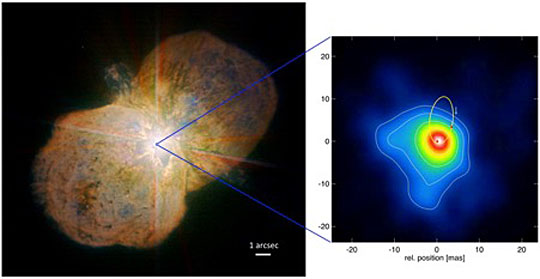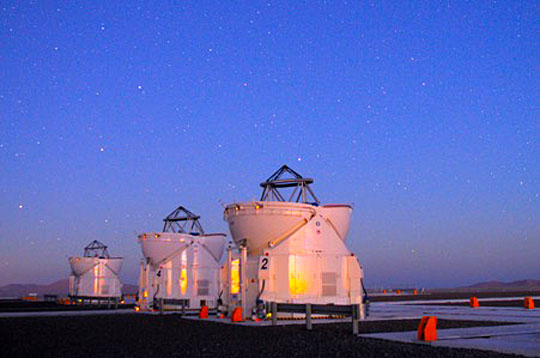A researcher at The University of Toledo is part of an international team of astronomers pioneering a new way to understand how extremely massive stars lose mass as they evolve.
The research team focused on the most luminous and massive stellar system in the Milky Way galaxy called Eta Carinae. Its primary star is 100 times more massive and five million times more luminous than the sun. That star also is famous for losing 10 suns worth of material — huge amounts of gas and dust — into space in an enormous explosion in the 1830s.These astronomers are the first to use what is called the Very Large Telescope Interferometer at the the European Southern Observatory in Chile to study the violent wind collision zone between two stars in the system and discover new and unexpected structures.

The nebula surrounding Eta Carinae as imaged with the European Southern Observatory Very Large Telescope at left. At right is a high-resolution image of the wind collision zone in the central region of Eta Carinae. The two red dots indicate the positions of the two stars.
The team’s methods used to revolutionize infrared astronomy and the resulting discoveries recently were published in the international journal Astronomy and Astrophysics.

This 3-D print of wind collision cavity in Eta Carinae system is based on models of Dr. Thomas Madura at San Jose University.
“It’s phenomenal,” said Richardson, who earned his bachelor’s degree in mathematics and master’s degree in physics from UT in 2004 and 2006. “Until now, we couldn’t study the Eta Carinae star system’s wind collision zone because it was too small for the largest telescope.”
The Eta Carinae star system is 7,500 light years from Earth where winds from two tightly orbiting stars smash together at speeds up to 10 million kilometers per hour approximately every five years. Temperatures reach many tens of millions of degrees – enough to emit X-rays.

This shows three 1.8-meter telescopes of the Very Large Telescope Interferometer of the European Southern Observatory in Chile.
“We’ve learned the secondary star’s wind is carving a cavity into the primary star’s enormous wind,” Richardson said. “We saw large structures pushed out into space after the winds collide, were able to pinpoint how they were moving, and learned they keep that geometric shape. It’s amazing to see the tails coming off, which are the shocks in the secondary star going into orbit. We have computer and 3-D print models that can now explain the X-rays, Hubble Space Telescope observations, unusual spectroscopic features, and the incredible images from the Very Large Telescope Interferometer.”
“Our dreams came true because we can now get extremely sharp images in the infrared regime,” said Dr. Gerd Weigelt of the Max Planck Institute for Radio Astronomy in Germany, who led the team of astronomers from the U.S., Canada, Chile, Japan and Brazil.
“Dr. Richardson’s work is a nice example of the kinds of international collaborations with which our UT astronomers are involved,” said Dr. Karen Bjorkman, dean of the UT College of Natural Sciences and Mathematics, Distinguished University Professor of Astronomy and Helen Luedtke Brooks Endowed Professor of Astronomy. “The results, which use data from the Hubble Space Telescope, show a very interesting way to map the fossil remnants of material thrown off by a famously unstable binary star system. I congratulate him on this work and am proud to note that he is a UT alumnus.”
Richardson hopes this new research helps astronomers come closer to understanding what triggered Eta Carinae’s explosion in the 1800s.
“That is one of the driving motivators for myself,” Richardson said. “How do we connect the physics of what is happening today to what happened back then? There is still a lot we don’t understand about the stars we have looked up and seen in the sky for a long time. Science is a process, and we want to push the envelope to solve the mystery.”